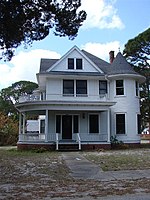St. Johns National Wildlife Refuge
Central Florida geography stubsFlorida protected area stubsIUCN Category VNational Wildlife Refuges in FloridaProtected areas established in 1971 ... and 1 more
Protected areas of Brevard County, Florida

The St. Johns National Wildlife Refuge is part of the United States National Wildlife Refuge System, located off SR 50 just west of Titusville. The 6,255 acre (25 km2) refuge was established in 1971 to protect the now extinct dusky seaside sparrow, Ammodramus maritimus nigrescens. It is administered as part of Merritt Island National Wildlife Refuge.
Excerpt from the Wikipedia article St. Johns National Wildlife Refuge (License: CC BY-SA 3.0, Authors, Images).St. Johns National Wildlife Refuge
Geographical coordinates (GPS) Address Nearby Places Show on map
Geographical coordinates (GPS)
| Latitude | Longitude |
|---|---|
| N 28.558333333333 ° | E -80.8875 ° |
Address
Brevard County (Brevard)
Florida, United States
Open on Google Maps





